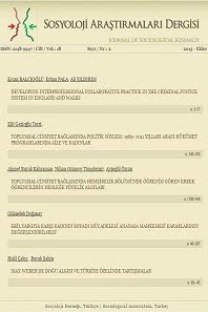Temsili Bir Örneklemde Sosyo-Ekonomik Statü (SES) Ölçüm Aracı Geliştirilmesi: Ankara Kent Merkezi Örneği
Sunulan çalışma, Ankara ilinde temsili bir örneklem üzerinden toplumsal tabakaları belirlemeye yönelik SES endeksi geliştirme ve farklı tabakalara ait özelliklerin belirlenmesi çalışmasıdır. Çalışmada örnekleme tasarımı olarak çok aşamalı küme örneklemesi yaklaşımı kullanılmıştır. Buna göre, Ankara kent merkezini oluşturan 8 merkez ilçe çalışma evreni olarak belirlenmiştir. Çalışmada, 1769 haneye ulaşılarak, hanelerin eğitim, iş, gelir, mülkiyet ve mülk edinme yolları ve tüketimi esas alan bir çerçevede veri toplanmıştır. Toplanan verilerle toplumsal tabakaların ölçülebilmesi için hangi değişkenlerin belirleyici olduğu istatistiksel yöntemle belirlenmiştir. Böylece gelir, iş/meslek, mülkiyet, eğitim, evde sahip olunan eşyalardan oluşturulan değişkenler ile sosyo-ekonomik statü endeksi geliştirilmiştir. SES endeksi geliştirildikten sonra belirlenen farklı tabakalardan temsili olarak seçilen bireylerde yaşam tarzı pratikleri de incelenmiştir.
Anahtar Kelimeler:
Sosyo-ekonomik statü, sınıf, SES endeksi Geliştirme.
Developing A Tool For The Measurement Of Socio -Economic Status (SES) From A Representative Sample: The Case Of Ankara City Center
The aim of the present study is to develop a socio-economic status index for determining the social strata and some features of different social strata by using a representative sample in Ankara city center. In the study, multi-stage sampling design is used as the sampling approach. According to this sampling, the universe of the study is eight central districts of Ankara. Data is collected about levels of education, employment, income, property, possessions and consumption from 1789 households which can be accessed.For the determination of indicators for measurement of SES advanced statistical techniques are used. So that a socio-economic status index is developed by indicators of income, employment status, occupation, property ownership, level of education and possession of objects in the house. After the determination of SES index, different life styles of representatively selected individuals from different social strata are also analysed.
___
- ATAY. F. 2002 Sınıf Tartışmaları: Türkiye’de Toplumsal Sınıflar Üzerine Dört Kitap, Praksis, Cilt No 8, pp. 315-321. ALTABAN, Ö. “Cumhuriyet’in Kent Planlama Politikaları ve Ankara Deneyimi”, 75 Yılda Değişen Kent ve Mimarlık içinde, ss.41-64, Türkiye İş Bankası Kültür Yayınları ve Tarih Vakfı ortak yayını, İstanbul.
- BLAU, P.M. ve DUNCAN, O.R. 1967 The American Occupational Structure, Wiley: New York. BREEN, R. 2005 “Foundations of Neo-Weberian Class Analysis”, in the book Approaches To Class Analysis, ed. by Erik Olin Wright. Cambridge: University Pres. BORATAV, K. Türkiye İktisat Tarihi (1908-1985), İstanbul: Gerçek. BORATAV, K. 1980’li Yıllarda Türkiye’de Sosyal Sınıflar ve Bölüşüm, İstanbul: Gerçek. BOURDIEU, P. 1986 Distinction: A social Critique of the Judgement of Taste, London / New York: Routledge. CROMPTON, R. 1993 Class and Stratification, Cambridge: Polity Press
- EDGELL, S and DUKE, V. A Measure of Thatcherism: A Sociology of Britain, Londra: Harper Colins. EDGELL, S. 1998 Sınıf, Dost Kitapevi Yayınları: Ankara
- DEVINE, F. SAVAGE, M. 2000 “Conclusion: Renewing Class Analysis”, in Renewing Class Analysis ed.by: Fiona Devine and Mike Savage, Blackwell Publishers, p: 193
- DEVINE, F. SAVAGE, M. 2005) “The Cultural Turn, Sociology and Class Analysis”, In Rethinking Class: Culture, Identities and Lifestyle, ed.by: Fiona Devine, Mike Savage, John Scott, Rosemary Crompton, Palgrave Macmillan, New York, p: 4 GIDDENS, A. 1973 The Class Structure of the Advanced Societies, London.
- GOLDTHORPE, J. H. “Women and Class Analysis: in Defence of the Conventional View”, Sociology, 17, pp. 465-488.
- GOLDTHORPE, J. H. (with Catriona Llewellyn and Clive Payne) 1987 Social Mobility and Class Structure in Modern Britain, Oxford: Clarendon Press.
- From Max Weber, essays in Sociology, London: Routledge and Kegan Paul.
- ISSN: 2148-9947
- Yayın Aralığı: Yılda 2 Sayı
- Başlangıç: 2010
- Yayıncı: Sosyoloji Derneği
Sayıdaki Diğer Makaleler
Y. Cemalettin ÇOPUROĞLU, BEYZADE NADİR ÇETİN
Sibel KALAYCIOĞLU, KEZBAN ÇELİK, ÜMİT ÇELEN, Sinan TÜRKYILMAZ
KAYHAN DELİBAŞ, ALİ ERDEM AKGÜL
Ailenin Karanlık Yüzü: Türkiye'de Ensest
Alanur BOZBEYOĞLU ÇAVLİN, Ece KOYUNCU, Filiz KARDAM, Altan SUNGUR
Türkiye'de Yoksulluğun ve Yoksulların Ana Akım Basında Temsili
